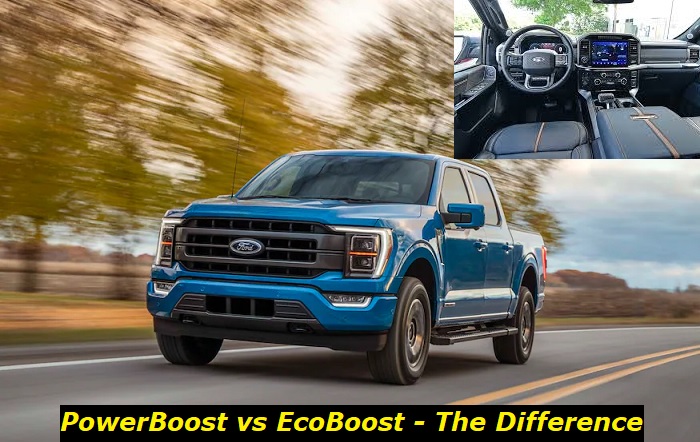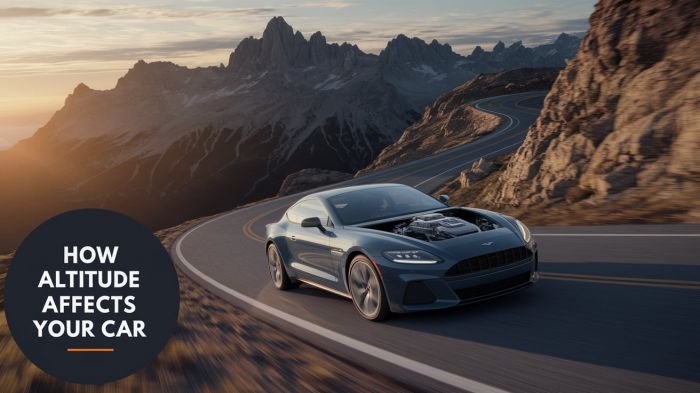The PowerBoost and EcoBoost technologies are currently two of the most impressive automotive engine technologies offered by Ford. Exemplified in the 3.5L PowerBoost Full Hybrid V6 and 3.5L EcoBoost V6 engines, truck lovers are left wondering, "what is the difference between both technologies?"
Key features and my opinion about the 3.5 EcoBoost engine
- Production years:2010-now
- Average lifespan of 3.5L EcoBoost:190,000-220,000 miles
- Fuel supply type:direct injection
- Power range:310-660 hp
- Fuel efficiency:average
- Engine block material:aluminum
- Engine reliability score:medium
- The most common problems:intercooler problems, timing chain stretching, carbon buildup on intake valves, coolant and oil leaks.
Key features and my opinion about the 3.5 PowerBoost engine
- Production years:2021-now
- Average lifespan of 3.5L V6 PowerBoost:200,000-240,000 miles
- Fuel supply type:direct injection
- Power range:430 hp
- Fuel efficiency:good
- Engine block material:aluminum
- Engine reliability score:medium
- The most common problems:oil leaks, turbocharger failure, overheating, spark plugs and ignition coils failure.

What is the EcoBoost Technology?
EcoBoost technology is the technology employed by Ford's EcoBoost engines. Ford has an impressive range of EcoBoost engines, from the 3-cylinder and 4-cylinder units all the way up to the 3.5L V6 EcoBoost engines used in the popular F150 pickup trucks.
Although the EcoBoost engines vary in size and design complexity, these engines use two main technologies. These are direct fuel injection technology and turbocharging.
The benefit of direct fuel injection technology is ensuring better control of how much fuel goes into each cylinder. This means that the EcoBoost engine uses the appropriate amount of fuel for each combustion event.
These high-pressure systems feed fuel into the cylinder in small precise amounts. The effect of this technology is a chiller and concentrated charge which leads to less fuel use.
The direct injection technology also allows many injections per combustion cycle. This increases the fuel economy greatly, especially when starting the engine.
Turbocharging is the second part of EcoBoost technology. Each EcoBoost engine is fitted with turbochargers to cram more air into the engine. The idea is that more air mixed with more fuel will increase the engine's power.
The turbochargers deliver a powerful low-end torque. This boosts the torque and engine performance despite the lesser displacement. The portable inertia rotors of the turbine allow for high torque with the least possible delay during fast acceleration.
The downsizing of the engine is another impressive element of the EcoBoost technology.
Special coatings to reduce friction and the use of aluminum also reduce the engine's weight. The benefit of all these measures is to reduce fuel use and co2 emissions.
Also, variable valve timing enhances the gas flow through the combustion chamber at all speeds, especially at part load and full torque. The EcoBoost technology can be summed up simply as the merger of powerful engine performance and fuel economy.
What is the PowerBoost Technology?
The PowerBoost technology has a lot in common with the EcoBoost technology. Ford modified the EcoBoost technology to make the PowerBoost technology. Ford took it further by creating a fully hybrid setup, attaching an electric powertrain to the EcoBoost engine.
So essentially, the PowerBoost is a 3.5L EcoBoost technology with a full hybrid powertrain to assist you.
The implication is that the vehicle can move in an all-electric mode. Other car brands have hybrid setups but do not compare to the PowerBoost technology.
For instance, RAM has a hybrid setup, but this setup requires the engine to run if you want to use the electrical setup.
In this PowerBoost technology, you have the regular 3.5L EcoBoost engine and transmission. But between those two, you have an electric powertrain to assist you.
PowerBoost vs EcoBoost - What's the Difference in Technology?
The PowerBoost technology is an upgrade of the EcoBoost technology. There is no special difference as both technologies use 6-cylinder V engines, twin turbochargers, and the same fuel injection technologies and internals.
However, on the point of difference, the main difference between the PowewrBoost technology and the EcoBoost technology is the addition of the electric powertrain system. This difference is discussed below.
You will also find a comparison of the products of both technologies below.
- Hybrid Powertrain Setup
The PowerBoost technology is the EcoBoost technology enhanced by adding a fully electric powertrain setup.
This Powertrain setup includes a 35 KW electric motor attached to the EcoBoost engine and a 1.5 kWh lithium-ion battery. This battery stores added power for when it is needed. Also, depending on your configuration, you can use all that extra electric power output for work.
Hence, with the 47HP electric motor, the PowerBoost technology enables your F150 truck to move as fast as 10MPH in electric mode only. Anything beyond that, the internal EcoBoost combustion engine takes over.
But in terms of detailed differences between both technologies, comparing two different engines that each use one of the technologies is only apt. These are discussed below.
- Horsepower Difference
Horsepower is one of the main concerns of every vehicle owner, especially when the vehicle is a truck. Horsepower refers to how much power the engine of a vehicle produces.
The 3.5L PowerBoost V6 engine produces 430 HP at 6000 RPM. This is 30 horsepower more than what the 3.5L EcoBoost V6 engine produces. The Ecoboost V6 engine produces only about 400 HP at 6000 PM.
So if you are looking for more engine power, there is no doubt that the PowerBoost technology is the best choice for you.
- Torque Difference
Torque is a twisting force. In simple terminology, torque is used to assess how much work an engine can do. Ideally, the more torque your engine has, the greater the amount of power your engine can produce.
For torque, the Powerboost technology beats the EcoBoost technology by leaps and bounds.
The 3.5L PowerBoost Full Hybrid V6 is rated 570 lb.-ft. @ 3,000 RPM while the 3.6L EcoBoost engine is rated 500 lb.-ft. @ 3,100 RPM.
What do these figures mean? In practice, engine designs aim to give the driver a high torque at the lowest and highest possible engine speed range. High torque means the shortest possible delay between acceleration and engine response.
High torque means a high degree of certainty and efficient propulsion for the driver when setting off or overtaking. However, there is always a momentary delay before the torque kicks in. But this is not the same with electric car engines.
The PowerBoost technology has a full hybrid engine which makes it different from the EcoBoost engine. This, coupled with the higher torque, makes the PowerBoost better in terms of torque than the EcoBoost technology.
- Towing Capacity Difference
The PowerBoost technology tends to have a lesser towing capacity compared to the EcoBoost technology.
The 3.5L EcoBoost V6 engine has a higher towing capacity than the 3.5L PowerBoost Full Hybrid V6. The EcoBoost engine can tow as much as 14000 pounds!
But the PowerBoost pales in comparison with its 12700 pounds towing capacity. That is some 1300 pounds difference in towing capacity.
A logical explanation for this difference in towing capacity between both engines is that the PowerBoost technology entails a fully hybrid powertrain that consists of a 47HP electric motor and a 1.5kWh lithium-ion battery which stores added power. These and other upgrades carry considerable weight on the bed already.
The EcoBoost technology, as in the EcoBoost engine, does not have all the extra powertrain and electrical features of the PowerBoost technology. This makes it light enough to carry all that extra 1300 pounds in addition to the towing capacity of the PowerBoost engine.
- Payload Difference
Payload is different from engine capacity, but people often make this mistake. While engine towing capacity is the amount of load a vehicle with an engine can pull, the payload is the amount of load that a vehicle with an engine can carry.
For payload capacity, the PowerBoost technology also pales compared to the EcoBoost technology.
The 3.5L EcoBoost V6 engine can carry up to 3250 pounds. But the 3.5L PowerBoost Full Hybrid V6 engine can only carry a maximum of 2120 pounds. That is an 1130 pounds difference!
So if you are looking for technology that can handle more payload, EcoBoost is the technology to go for!
Bottom Line
The PowerBoost technology is an upgrade from the EcoBoost technology. The addition of the powerful electric powertrain is the upgrade that sets it apart from the EcoBoost technology.
But while it has this upgrade, there are several sacrifices that trucks with this upgrade must make. These include a reduction in payload difference and towing capacity.
Overall, the Powerboost technology seems to be better than the EcoBoost technology. But the choice of which is better will ultimately depend on each driver's individual needs.
If you need more speed and you intend to have a mobile power source for work, the PowerBoost technology is the choice for you. But if you want to have a truck that can move weight, the EcoBoost technology is the technology to go for.
About the authors
The CarAraC research team is composed of seasoned auto mechanics and automotive industry professionals, including individuals with advanced degrees and certifications in their field. Our team members boast prestigious credentials, reflecting their extensive knowledge and skills. These qualifications include: IMI: Institute of the Motor Industry, ASE-Certified Master Automobile Technicians; Coventry University, Graduate of MA in Automotive Journalism; Politecnico di Torino, Italy, MS Automotive Engineering; Ss. Cyril and Methodius University in Skopje, Mechanical University in Skopje; TOC Automotive College; DHA Suffa University, Department of Mechanical Engineering






Add comment